How to Get Vietnam Work Visa: Complete Guide for Foreigners 2025
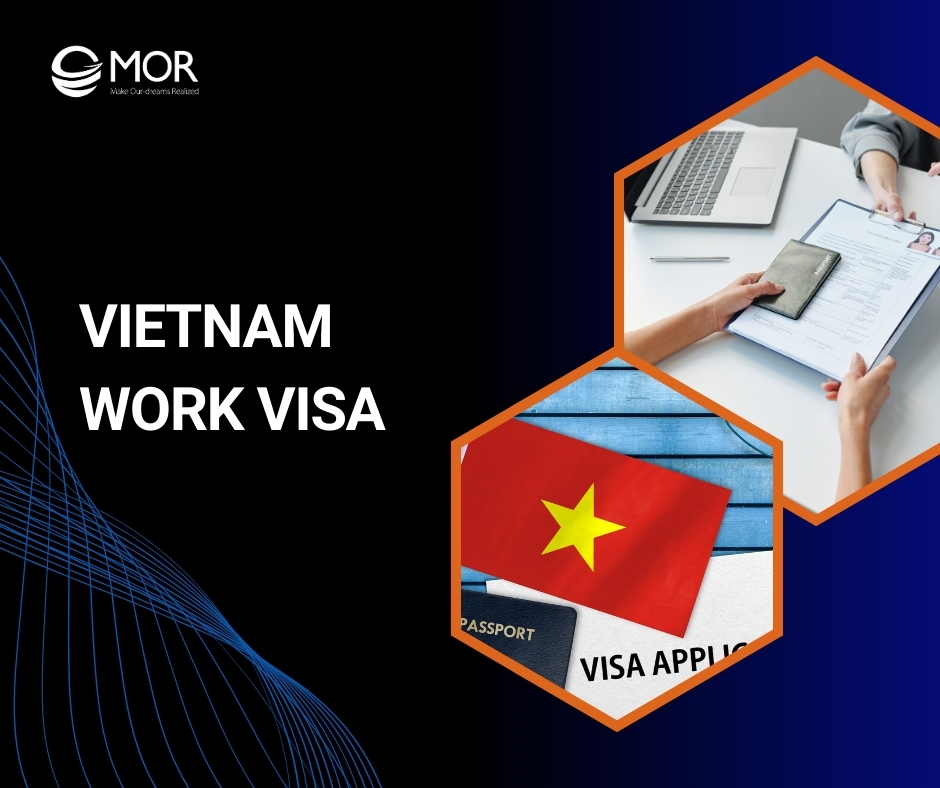
Applying for a Vietnam work visa can be confusing, especially with strict rules on sponsorship, paperwork, and timing. Many foreigners still ask questions like “can I work in Vietnam on a tourist visa” only to face rejections or legal risks. This MOR Software’s guide will walk you through the complete process for 2025, helping you avoid common mistakes and secure the right visa smoothly.
What Is A Vietnam Work Visa?
A Vietnam work visa (commonly called an LD visa) is the legal document that allows foreigners to enter and stay in Vietnam for employment purposes. It is only issued after the sponsoring company or organization in Vietnam secures a valid work permit on behalf of the employee.
By the end of 2024, Viet Nam had about 161,992 foreign workers, including 149,195 under the work permit regime and 12,797 exempt. This shows how central the LD visa and permits are to lawful employment.
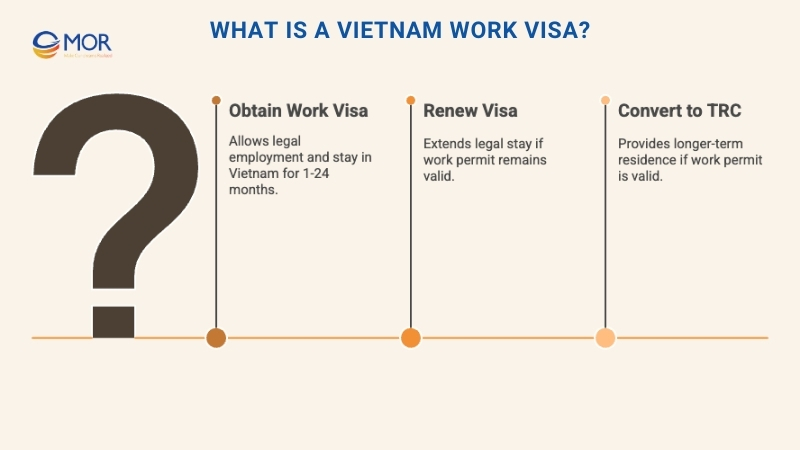
The visa is usually granted for a period between 1 month and 24 months, depending on the type requested and the work permit’s validity. Once it expires, the visa can be extended or converted into a Temporary Residence Card (TRC) as long as the work permit is still in effect.
Put simply, you need a visa to work in Vietnam if you plan to be employed here.
>>> READ MORE: TOP 10+ Vietnam Software Outsourcing Company [2025 Updated]
Who Can Apply For A Vietnam Work Visa?
Under Vietnam’s Labor Code 2019, Article 151.1, foreigners must meet several legal conditions before they can receive a Vietnam work visa:
- Must be 18 years or older and fully capable of civil acts.
- Possess appropriate professional skills, work experience, and good health, as regulated by the Ministry of Health.
- Cannot be someone serving a criminal sentence, under prosecution, or with an unrepealed criminal record under either Vietnamese or foreign law.
- Hold a valid work permit Vietnam issued by the competent authority, unless falling under the exempted cases stated in Article 154 of the Labor Code.
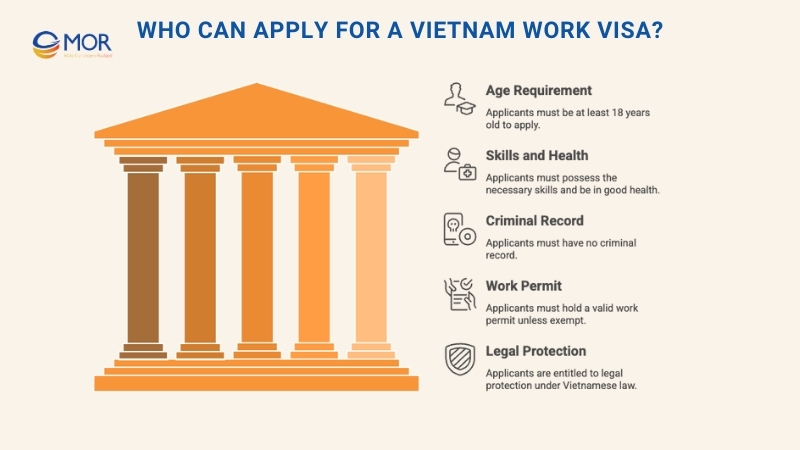
All foreign workers having intend doing business in Vietnam are required to comply with these rules and the Vietnamese Labor Code. At the same time, they are entitled to legal protection in Vietnam, unless international treaties signed by the Socialist Republic of Vietnam stipulate otherwise.
Who Needs A Vietnam Work Visa?
According to Decree 152/2020/ND-CP on foreign employment, those subject to a Vietnam work visa are foreigners entering the country for purposes such as:
- Fulfilling labor contracts.
- Taking part in intra-company transfers.
- Carrying out contracts or agreements in areas like business, finance, banking, insurance, education, culture, science and technology, healthcare, or sports.
- Delivering services under contracts.
- Offering commercial services.
- Working with foreign NGOs or international organizations legally licensed in Vietnam.
- Holding positions as managers, directors, experts, or technical staff.
- Participating in project implementation or bid contracts in Vietnam.
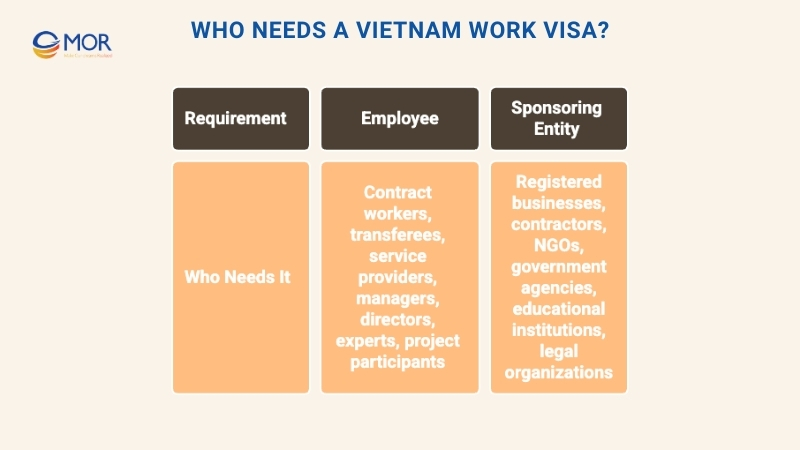
The regulation also defines which organizations are qualified to sponsor a work permit for foreign employees. These include:
- Enterprises established under the Enterprise Law, Investment Law, or international treaties involving Vietnam.
- Licensed contractors executing bids and projects.
- Representative offices, branches, and organizations approved by authorities.
- State agencies, political and socio-political bodies, and professional associations.
- Foreign NGOs licensed to operate in Vietnam.
- Non-business units and legally established educational institutions.
- International organizations or foreign project offices recognized by the Vietnam government.
- Operational offices of foreign investors or contractors licensed in Vietnam.
- Legal entities such as cooperatives, unions of cooperatives, and organizations practicing law in Vietnam.
- Business households or individuals allowed to operate under Vietnamese law.
These rules apply to any Vietnam visa for foreigners who plan to work or set up company in Vietnam.
Why Is Vietnam Work Visa (LD Visa) Legally Required?
For foreigners seeking formal, long-term employment in Vietnam, the Vietnam work visa (LD visa) is not optional but a strict legal requirement. Unlike a business visa Vietnam, which is mainly for meetings or short-term activities, the LD visa is tailored for those working under labor contracts or holding executive, specialist, or technical positions in a local company.
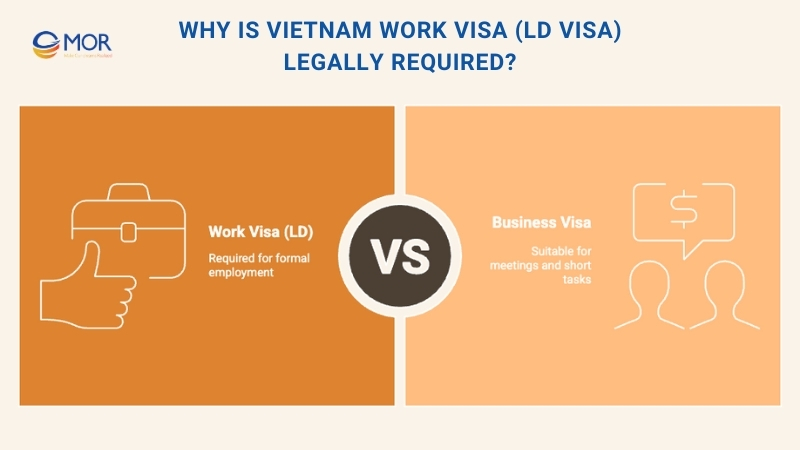
People often ask, can you work in Vietnam on a tourist visa? The short answer is no. Any employment without an LD visa, supported by a valid work permit Vietnam unless exempt, is considered illegal. Violations can lead to fines, deportation, or other penalties under Vietnamese labor and immigration regulations.
Under Decree 12/2022, a foreign worker without a permit can be fined from VND 15 million to 25 million and may be deported, while employers face fines ranging from VND 30 million to 75 million for individuals, doubled for organizations, depending on how many unpermitted workers are involved.
>>> READ MORE: Top 10 Market Entry Strategy For Businesses To Know In 2025
Vietnam Work Visa Categories: LD1 And LD2
The Vietnam work visa is classified into two types, LD1 and LD2. Each category has its own rules depending on whether the applicant is exempt from or required to hold a work permit. Knowing these differences is crucial to avoid mistakes and remain compliant with Vietnamese law.
Category | LD1 Visa | LD2 Visa |
| Work permit required | No – granted to applicants exempt under legal conditions | Yes – must have a valid work permit first |
| Eligible applicants | Company owners, board members, licensed lawyers, intra-company transferees | Foreign experts, managers, technical workers with signed labor contracts |
| Legal basis | Article 7 – Decree 152/2020/NĐ-CP | Article 11 – Decree 152/2020/NĐ-CP |
| Sponsor required | Yes – a legally established company in Vietnam | Yes – a legally established company in Vietnam |
| Visa validity | Up to 2 years | Up to 2 years, in line with work permit duration |
| TRC eligibility | Yes | Yes |
| Approval required | Confirmation of exemption issued by labor authorities | Approved work permit must be presented |
| Common use cases | Business investors, intra-company transferees, legal professionals | Long-term employees under formal contracts |
By distinguishing between LD1 and LD2 visas, applicants can choose the right path early, making the Vietnam work visa process smoother and fully compliant.
Work Permit Rules And TRC Eligibility For Vietnam Work Visa Holders
Vietnamese labor and immigration laws state that most foreigners must secure a valid work permit Vietnam before starting any official employment. In some situations, this requirement can be waived if the individual falls under specific legal exemptions.
Understanding these rules is vital, as they directly affect your ability to qualify for long-term residency options such as a Temporary Residence Card (TRC) linked to your Vietnam work visa.
When Is A Work Permit Required?
A work permit is mandatory for most foreign nationals who intend to work in Vietnam for over 30 days with a signed labor contract. It is the legal foundation for an LD2 visa and confirms lawful employment status in the country.
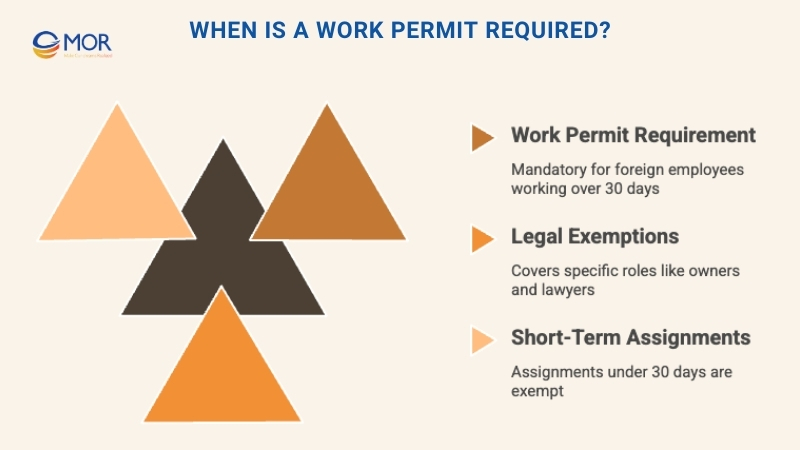
You will need a work permit if you are:
- Hired under a labor contract by a Vietnamese enterprise
- Working as a specialist, technical worker, or manager
- Serving as an executive in a foreign-invested company
- Assigned to a project office or representative office in Vietnam
- Not eligible under any exemption category provided by law
Work permit exemptions, outlined in Decree 152/2020/NĐ-CP, cover:
- Owners or members of the board of Vietnamese companies
- Intra-company transferees working for multinational corporations
- Licensed foreign lawyers practicing in Vietnam
- Volunteers or students on internships recognized by the state
- Assignments lasting less than 30 consecutive days, provided total stays do not exceed 90 days in a year
Determining whether you need a work permit is the first step toward a compliant Vietnam work visa application. It directly impacts both your visa approval and your ability to secure long-term residency in the country.
Temporary Residence Card (TRC) for Vietnam Work Visa Holders
A Temporary Residence Card (TRC) is a long-term residency document issued to foreigners who already hold a valid Vietnam work visa and work permit. Acting as both a residence permit and a re-entry pass, it removes the need for repeated visa extensions during its validity period.
Main benefits of a TRC include:
- Valid for 1–2 years, depending on the duration of the work permit and visa
- Grants unlimited entries and exits without applying for new visas. This helps with frequent Vietnam travel without repeated visa runs.
- Provides legal grounds for living and working in Vietnam long-term
- Supports everyday needs such as opening a bank account, renting housing, or registering dependents
- Allows holders to sponsor family members (spouse and children) for dependent TRCs
Eligibility requirements:
- Must hold an LD1 or LD2 visa
- Have an approved work permit or exemption notice
- Proof of legal residence in Vietnam, confirmed by local police
- Sponsorship from a licensed employer in Vietnam
Documents needed:
- Passport and valid visa copy
- Work permit or exemption approval
- Application forms NA6 (sponsor) and NA8 (applicant)
- Residence confirmation issued by local authorities
- Company registration or business license (ERC)
For anyone with a Vietnam work visa, a TRC is the practical way to secure long-term stability. It streamlines immigration procedures and creates a smoother path for both professional commitments and personal life in Vietnam.
>>> READ MORE: TOP 10 Leading Salesforce Companies in Vietnam Updated 2024
Step-By-Step Process To Obtain A Vietnam Work Visa
Getting a Vietnam work visa involves several stages that require coordination between the applicant and their sponsoring company. Each step must be completed in the proper order, as mistakes or missing documents can cause significant delays or even a rejection. Below is the full breakdown of how the process works.
Step | Description | Responsible Party | Key Documents / Requirements | Expected Outcome |
Step 1 | Request for labor demand approval The employer submits an application to the Department of Labor to justify the need for hiring a foreign worker. | Employer | Labor demand request form, job description, enterprise registration certificate (ERC) | Approval to proceed with recruitment of a foreign employee |
Step 2 | Work Permit Application (if required) The employer files the application, supported by the employee’s documents, to obtain legal permission for employment. | Employer (with employee assistance) | Work permit application form, medical certificate, criminal record, proof of qualifications | Work permit issued with a validity of up to 2 years |
Step 3 | Visa Application (LD1 or LD2) Apply for the appropriate visa at an overseas embassy or the Immigration Department in Vietnam, based on the work permit or exemption. | Employer or authorized representative | Valid passport, visa application form (NA2 or NA5), work permit or exemption certificate | LD visa granted for up to 2 years |
Step 4 | Entry and TRC Application After entering Vietnam, the employee applies for a Temporary Residence Card (TRC) to stay long term. | Employee (with company support) | Work permit or exemption, proof of residence, NA6 and NA8 forms, passport | TRC issued (1–2 years), confirming legal residency status |
Completing each step in sequence is the only way to secure a Vietnam work visa legally. With proper documents and a qualified sponsor, foreign professionals can establish long-term employment and residency in Vietnam with confidence.
Required Documents For Vietnam Work Visa Applications
When applying for a Vietnam work visa, both the foreign worker and the sponsoring company must prepare a complete set of papers. Incomplete or incorrect submissions are among the most frequent reasons for delays or rejections. While LD1 and LD2 visas have slight variations, the fundamental requirements remain the same.

Preparing accurate and complete paperwork is the best way to avoid visa complications.
Standard Documents For LD Visa
The following documents are required for all applicants seeking an LD1 or LD2 Vietnam work visa:
From the Foreign Applicant | From the Sponsoring Employer |
| Valid passport (minimum 6 months validity, at least 2 blank pages) | Enterprise Registration Certificate (ERC) |
| Two passport-sized photos (4×6 cm, white background) | Official request for visa issuance |
| Completed visa application form (NA2 or NA5) | Approval letter for foreign labor use (if required) |
| Health certificate issued within the last 12 months | Signed labor contract or assignment letter (if applicable) |
| Criminal record from home country or previous residence (issued within 6 months) | Company seal and legal representative’s signature |
| Notarized educational qualifications, translated into Vietnamese | Visa sponsorship documents following Immigration Department format |
| Work permit (for LD2 applicants) or exemption certificate (for LD1) | Support documents for residence confirmation, if applying for TRC |
All documents in foreign languages must be translated into Vietnamese and notarized. In many cases, they must also be legalized at the consulate general of Vietnam in the applicant’s home country before submission. Requirements are similar across nationalities, including Vietnam visa for US citizens.
Employer-Side Documents
The sponsoring company is directly responsible for providing the paperwork that supports a Vietnam work visa application. Without these documents, the foreign applicant’s file will not be accepted. Below are the standard papers that every employer must prepare and submit together with the employee.
Missing or outdated company documents will halt the visa application process entirely.
Key employer-side documents include:
- Enterprise Registration Certificate (ERC): Valid license proving the company’s legal status
- Official request for visa issuance: Letter stating job title, purpose of employment, and intended duration
- Labor demand approval: Confirmation from the Department of Labor authorizing the hire of foreign staff
- Signed labor contract or internal transfer decision: Required when applicable
- Company seal and legal representative’s signature: Must appear consistently on all official documents
- Work permit approval (for LD2 applicants) or exemption confirmation (for LD1 applicants)
- Registered office address or lease contract: Used for residence confirmation when applying for a TRC
Employers must ensure all documents are current, signed, and stamped correctly. Errors or inconsistencies in the company’s paperwork are among the most common reasons for delays in processing a Vietnam work visa.
>>> READ MORE: Outsourcing IT to Vietnam: Pros & Cons and How to Get Started in 2024
Validity, Renewal, And Upgrade Options For Vietnam Work Visa
Foreign professionals must understand the duration of a Vietnam work visa and the available options to extend or upgrade it. Visa terms are directly tied to the employment contract, work permit, and visa type, all of which decide how long the holder can stay and work legally in the country.
Knowing the validity rules of the Vietnam work visa helps avoid gaps in legal residency.
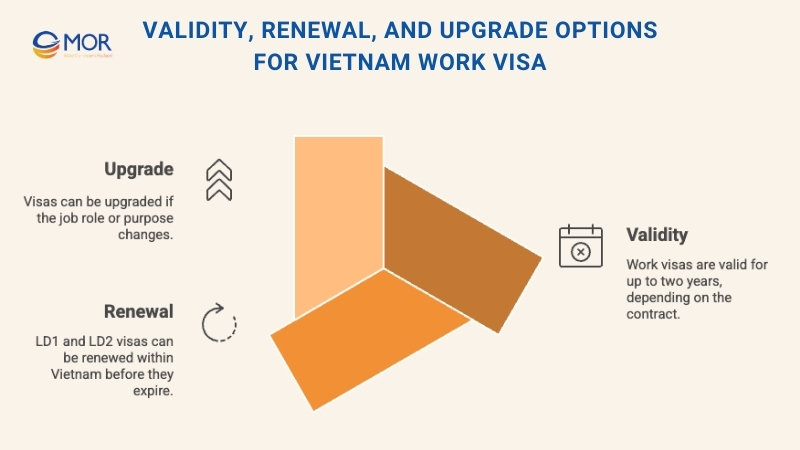
How Long Is A Vietnam Work Visa Valid?
The validity of an LD1 or LD2 Vietnam work visa generally matches the duration of the work permit and labor contract, with a maximum term of two years.
Standard validity periods:
- LD1 visa (work permit exemption): Up to 2 years
- LD2 visa (requires work permit): Up to 2 years, aligned with the permit’s validity
Shorter validity may apply if limited by:
- Length of the signed employment contract
- Remaining validity of the passport
- Expiry date of the employer’s business license
Extension and TRC notes:
- LD visas can be renewed or upgraded inside Vietnam once they expire
- Eligible holders may apply for a Temporary Residence Card (TRC) with the same duration as the visa
- Renewal should be initiated 15–30 days before expiry to prevent overstay penalties
Foreign employees should align their visa with the work permit at all times. When changing employers or moving into investment roles, it may be necessary to switch to another visa category, such as a DT visa.
Renewing Or Upgrading A Vietnam Work Visa
Both LD1 and LD2 categories of the Vietnam work visa can be renewed or upgraded, depending on employment status and long-term residency plans. Renewals are carried out before the visa expires, while upgrades involve switching to a different visa category, such as from DN to LD, or from LD to DT.
Aspect | Visa Renewal | Visa Upgrade |
| Definition | Extending the validity of an existing LD1 or LD2 visa | Changing from one visa type to another (e.g., DN → LD, LD → DT) |
| Eligibility | Ongoing employment with a valid work permit or exemption confirmation | Change in job role, investment status, or visa purpose |
| Common Scenarios | Continuing employment with the same company | Starting formal work after entering on DN visa, becoming an investor |
| Application Location | Vietnam Immigration Department (in-country) | May require applying again from abroad depending on visa type |
| Key Requirements | Valid passport, current visa, updated work permit, employer documents | Complete set of papers for the new visa category |
| Processing Time | Around 5–7 working days | Around 5–10 working days (varies by case and authority) |
| TRC Eligibility | Yes, provided the work permit remains valid | Depends on the new visa class (e.g., DT1–DT3 eligible, DT4 not) |
| Risk / Complexity | Low if all documents are accurate and complete | Medium to high, as it may require exit and re-entry or extra legal steps |
Renewing a Vietnam work visa is usually simple when employment conditions remain unchanged. For those moving into new roles or investment positions, upgrading ensures legal compliance with the updated purpose of stay in Vietnam.
Common Vietnam Work Visa Mistakes To Avoid
Many foreign employees and their sponsoring companies run into legal trouble because of confusion about visa categories and immigration procedures. Being aware of common errors helps maintain compliance and protects both workers and businesses from fines, delays, or even visa rejection.
Misunderstanding the rules is one of the fastest ways to violate immigration law.
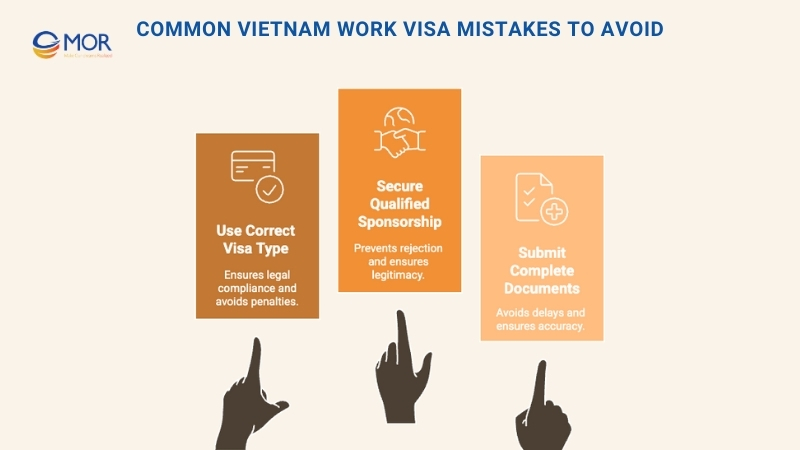
Using A Business Visa Instead Of A Work Visa
Another frequent mix-up is, can I work in Vietnam on a tourist visa. You cannot. A common but serious mistake is relying on a business visa Vietnam (DN visa) to perform full-time employment.
The DN visa is strictly for short-term business activities such as meetings, contract negotiations, or investment exploration. It is not valid for salaried roles or daily operational management.
Why this mistake is serious:
- It directly violates labor and immigration regulations
- Foreigners working on a DN visa without a valid Vietnam work visa and work permit risk visa cancellation, fines, deportation, and future entry bans
- Employers may face administrative penalties or threats to their business license
Under Decree 152/2020/NĐ-CP, all foreigners employed under labor contracts must hold both a valid work permit and an LD visa.
Applying Without A Qualified Sponsor
One of the most common errors in applying for a Vietnam work visa is attempting to do so without a legitimate sponsor. Foreign nationals cannot apply for LD1 or LD2 visas on their own; sponsorship from a legally registered company or organization in Vietnam is mandatory.
Why this becomes a serious problem:
- The sponsoring employer is responsible for both the visa and the work permit
- Applications without a recognized sponsor are automatically rejected
- Using a third-party or “paper” company that is not your actual employer can result in visa cancellation, financial penalties, or denial of a Temporary Residence Card (TRC)
A proper sponsor must provide:
- Valid Enterprise Registration Certificate (ERC)
- Official labor demand approval letter
- Visa sponsorship request letter
- Signed labor contract with the foreign employee
- Proof of office address and legal business activities
Always confirm that your sponsoring company is fully licensed and compliant with immigration laws. Having the right sponsor is the foundation for a smooth and lawful Vietnam work visa application. Vietnam manages foreign workers from about 110 countries. This explains why authorities require clear, legitimate sponsorship for each case
Submitting Incomplete Or Incorrect Documents
One of the main reasons for Vietnam work visa delays or outright rejection is submitting paperwork that is incomplete, outdated, or inconsistent. Even small mismatches between your documents and official records can cause serious processing problems.
Frequent documentation mistakes include:
- Inconsistent details across passport, visa forms, and labor contracts
- Missing notarized Vietnamese translations of degrees, police records, or medical certificates
- Using expired documents, such as criminal records older than six months
- Not providing residence confirmation from local police for TRC applications
- Submitting forms with unofficial templates or formats not accepted by the Immigration Department
Consequences of incorrect or missing paperwork:
- Visa application rejection or lengthy delays
- Having to restart the entire process from the beginning
- Risk of overstay fines if your current visa expires while reapplying
Careful preparation and review of documents are essential for a smooth Vietnam work visa application. When the dossier is complete, the Government now requires a work permit decision within ten working days, so missing items can easily push you beyond that timeline.
Conclusion
Getting a Vietnam work visa takes proper planning, accurate paperwork, and the backing of a qualified sponsor. Choosing the right visa type and preparing documents carefully helps you stay compliant and avoid delays or rejections. If you plan to apply for a Vietnam work visa in 2025, start early, follow the rules, and partner with the right support. Contact us to see how MOR Software can assist you with a smooth and compliant process.
MOR SOFTWARE
Frequently Asked Questions (FAQs)
How do I get a work visa for Vietnam?
To obtain a work visa in Vietnam, employees usually need to:
- Secure a letter of confirmation from their employer in Vietnam.
- Prepare three recent passport-sized photographs.
- Obtain a valid health certificate from a hospital either in Vietnam or in their home country.
- Complete additional documents as required by Vietnamese authorities.
How long does it take to get a Vietnamese work permit?
Once the application is fully submitted, the relevant authority usually issues the work permit within five working days. However, the entire process, from preparing documents to final approval, often takes between 1.5 and 2 months.
How much is a Vietnam work permit?
The fee depends on the visa duration and entry type:
- Multiple-entry visa (3–6 months): $95 USD
- Multiple-entry visa (6–12 months): $135 USD
- Multiple-entry visa (12 months–2 years): $145 USD
- Multiple-entry visa (2–5 years): $155 USD
Can a foreigner work in Vietnam?
Yes, but foreigners must meet certain conditions outlined in the 2019 Labour Law. These include being at least 18 years old, having full civil capacity, and providing proof of qualifications, professional skills, or relevant work experience.
How long does it take to get a work permit?
Processing times vary depending on the type of application. Generally, work permits can take anywhere from 2 to 8 months when applying through agencies such as USCIS. The timeline depends on application category and workload.
How much does it cost for a 5-year visa to Vietnam?
A long-term visa valid for 2 to 5 years costs US$155. Shorter validity visas range from US$135 to US$145 depending on the duration. Children under 14 are charged US$25 regardless of visa length.
What is the difference between a work permit and a work visa in Vietnam?
A work visa allows a foreigner to enter and stay in Vietnam legally, while a work permit is the document that grants permission to take up employment. Both are necessary for foreign workers to work lawfully in Vietnam.
Can I work in Vietnam with a tourist visa?
No. Employment is strictly prohibited on a tourist visa. Working without the correct authorization can result in penalties, deportation, and future entry bans. A valid work visa and work permit are required.
How long can you stay in Vietnam on a work visa?
Work visas are issued for varying periods: one month, three months, six months, or one year. They may be granted for single or multiple entries. For longer stays, workers can apply for a temporary residence card once they hold a work permit.
How to extend a visa in Vietnam?
- Collect the necessary documents.
- Submit them through a licensed travel agency to the Vietnam Immigration Department.
- Pay the extension fee, which varies by visa type.
- Wait for processing, which typically takes about five working days.
How to live in Vietnam permanently as a foreigner?
Permanent residency is possible for foreigners who make significant investments in Vietnam, either in businesses or real estate. The government offers this option to encourage and reward long-term investors.
Rate this article
0
over 5.0 based on 0 reviews
Your rating on this news:
Name
*Email
*Write your comment
*Send your comment
1